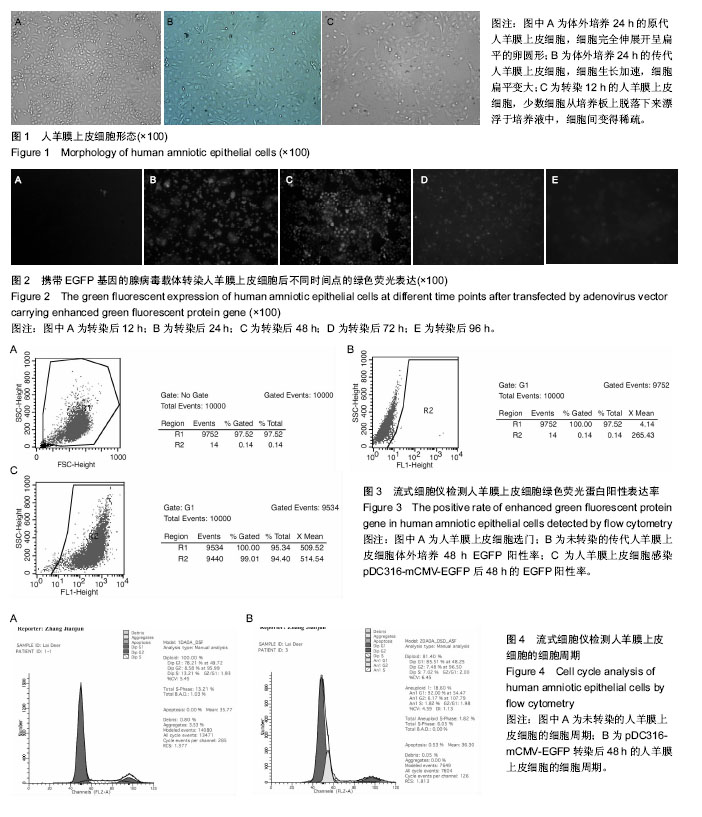| [1] Amin HD, Brady MA, St-Pierre JP, et al. Stimulation of chondrogenic differentiation of adult human bone marrow-derived stromal cells by a moderate-strength static magnetic field. Tissue Eng Part A. 2014;20(11-12):1612-1620.[2] Li G, Zheng B, Meszaros LB, et al. Identification and characterization of chondrogenic progenitor cells in the fascia of postnatal skeletal muscle. J Mol Cell Biol. 2011;3(6): 369-377.[3] 刘峰舟,尹纯,孙夏承,等.AKAP1过表达腺病毒载体构建及其在心肌细胞中的功能初步研究[J].心脏杂志,2017,29(4):405-410.[4] Fernandes P, Simão D, Guerreiro MR, et al. Impact of adenovirus life cycle progression on the generation of canine helper-dependent vectors. Gene Ther. 2015;22(1):40-49.[5] Reddy VS, Nemerow GR. Structures and organization of adenovirus cement proteins provide insights into the role of capsid maturation in virus entry and infection. Proc Natl Acad Sci U S A. 2014;111(32):11715-11720.[6] Chalfie M, Tu Y, Euskirchen G, et al. Green fluorescent protein as a marker for gene expression. Science. 1994;263(5148): 802-805.[7] Listwan P, Martin JL, Kobe B,et al. Methods for high-throughput protein expression, purification and structure determination adapted for structural genomics. Australian Biochemist. 2004; 35(2):43-46.[8] Feilmeier BJ, Iseminger G, Schroeder D, et al. Green fluorescent protein functions as a reporter for protein localization in Escherichia coli. J Bacteriol. 2000;182(14): 4068-4076.[9] Shaner NC, Steinbach PA, Tsien RY. A guide to choosing fluorescent proteins. Nat Methods. 2005;2(12):905-909.[10] 金玲,陈剑,吴静,等.慢病毒介导EGFP基因修饰的人羊膜上皮细胞重建角膜表层的实验研究[J].中华实验眼科杂志,2011,29(8): 685-689.[11] 刘小勇,陈剑,吴静,等.人羊膜上皮细胞体外培养重建角膜上皮的实验研究[J].中国病理生理杂志,2012,28(4):689-693.[12] Liu XY, Chen J, Zhou Q, et al. In vitro tissue engineering of lamellar cornea using human amniotic epithelial cells and rabbit cornea stroma. Int J Ophthalmol. 2013;6(4):425-429.[13] Zhou Q, Liu XY, Ruan YX, et al. Construction of corneal epithelium with human amniotic epithelial cells and repair of limbal deficiency in rabbit models. Hum Cell. 2015;28(1): 22-36.[14] 刘小勇,陈剑,吴静,等.人羊膜上皮细胞的原代及传代培养[J].广东医学,2007,28 (2):181-183.[15] 金玲,陈剑,吴静,等.人羊膜上皮细胞的分离、纯化及其生物学特性研究[J].广东医学,2010,31(16):2055-2057.[16] 刘小勇,周清,张晓玲,等.人羊膜上皮细胞的体外培养及标记分子的检测分析[J].细胞与分子免疫学杂志, 2014, 30(12): 1318-1321.[17] Lefebvre S, Adrian F, Moreau P, et al. Modulation of HLA-G expression in human thymic and amniotic epithelial cells. Hum Immunol. 2000;61(11):1095-1101.[18] Li H, Niederkorn JY, Neelam S, et al. Immunosuppressive factors secreted by human amniotic epithelial cells. Invest Ophthalmol Vis Sci. 2005;46(3):900-907.[19] Banas RA, Trumpower C, Bentlejewski C, et al. Immunogenicity and immunomodulatory effects of amnion-derived multipotent progenitor cells. Hum Immunol. 2008;69(6):321-328.[20] Miki T, Strom SC. Amnion-derived pluripotent/multipotent stem cells. Stem Cell Rev. 2006;2(2):133-142.[21] Ilancheran S, Michalska A, Peh G, et al. Stem cells derived from human fetal membranes display multilineage differentiation potential. Biol Reprod. 2007;77(3):577-588.[22] Shinya M, Komuro H, Saihara R, et al. Neural differentiation potential of rat amniotic epithelial cells. Fetal Pediatr Pathol. 2010;29(3):133-143. [23] Lin JS, Zhou L, Sagayaraj A, et al. Hepatic differentiation of human amniotic epithelial cells and in vivo therapeutic effect on animal model of cirrhosis. J Gastroenterol Hepatol. 2015; 30(11):1673-1682.[24] Ji H,Yang Q,Ji F,et al.Human amniotic epithelial cell transplantation for the repair of injured brachial plexus nerve: evaluation of nerve viscoelastic properties. Neural Regen Res. 2015;10(2): 260-265.[25] Wang TG,Xu J,Zhu AH,et al.Human amniotic epithelial cells combined with silk fbroin sca?old in the repair of spinal cord injury.Neural Regen Res.2016;11(10): 1670-1677.[26] Mahmood R, Choudhery MS, Mehmood A, et al. In Vitro Differentiation Potential of Human Placenta Derived Cells into Skin Cells. Stem Cells Int. 2015;2015:841062.[27] Fliniaux I, Viallet JP, Dhouailly D, et al. Transformation of amnion epithelium into skin and hair follicles. Differentiation. 2004;72(9-10):558-565.[28] Okere B, Alviano F, Costa R, et al. In vitro differentiation of human amniotic epithelial cells into insulin-producing 3D spheroids. Int J Immunopathol Pharmacol. 2015; 28(3): 390-402.[29] Ginsberg M, Schachterle W, Shido K, et al. Direct conversion of human amniotic cells into endothelial cells without transitioning through a pluripotent state. Nat Protoc. 2015; 10(12):1975-1985.[30] Yang SP, Yang XZ, Cao GP. Conjunctiva reconstruction by induced differentiation of human amniotic epithelial cells. Genet Mol Res. 2015;14(4):13823-13834. [31] Tabatabaei M, Mosaffa N, Nikoo S, et al. Isolation and partial characterization of human amniotic epithelial cells: the effect of trypsin. Avicenna J Med Biotechnol. 2014;6(1):10-20.[32] Wolbank S, van Griensven M, Grillari-Voglauer R, et al. Alternative sources of adult stem cells: human amniotic membrane. Adv Biochem Eng Biotechnol. 2010;123:1-27.[33] Pappa KI, Anagnou NP. Novel sources of fetal stem cells: where do they fit on the developmental continuum. Regen Med. 2009;4(3):423-433.[34] Jiang TS, Cai L, Ji WY, et al. Reconstruction of the corneal epithelium with induced marrow mesenchymal stem cells in rats. Mol Vis. 2010;16:1304-1316.[35] Tsai CL, Chuang PC, Kuo HK, et al. Differentiation of Stem Cells From Human Exfoliated Deciduous Teeth Toward a Phenotype of Corneal Epithelium In Vitro. Cornea. 2015; 34(11): 1471-1477.[36] Ahmad S, Stewart R, Yung S, et al. Differentiation of human embryonic stem cells into corneal epithelial-like cells by in vitro replication of the corneal epithelial stem cell niche. Stem Cells. 2007;25(5):1145-1155.[37] Blazejewska EA, Schlötzer-Schrehardt U, Zenkel M, et al. Corneal limbal microenvironment can induce transdifferentiation of hair follicle stem cells into corneal epithelial-like cells. Stem Cells. 2009;27(3):642-652. [38] Nishida K, Yamato M , Hayashida Y, et al. Corneal reconstruction with tissue- engineered cell sheets composed of autologous oral mucosal epithelium. N Engl J Med. 2004; 351(12):1187-1196.[39] Inoshita S, Koizumi N, Nakamura T, et al.Transplantable cultivated mucosal epithelial sheet for ocular surface reconstruction. Exp Eye Research. 2004;78(3):483-491.[40] Noshita S, Nakamura T, et al.Development of cultivated mucosal epithelial transplantation for Ocular surface reconstruction. Artificial Organs. 2004;28(1): 22-27.[41] Inatomi T, Nakamura T, Koizumi N, et al. Midterm results on ocular surface reconstruction using cultivated autologous oral mucosal epithelial transplantation .Am J Ophthalmol. 2006; 141(2):267-275. |
.jpg)

.jpg)